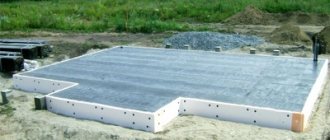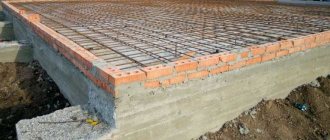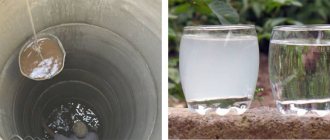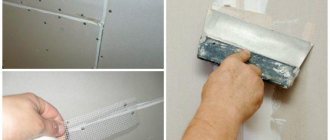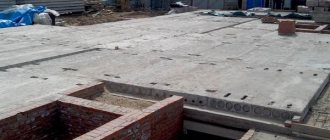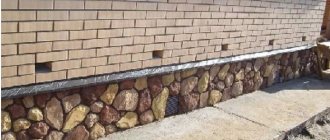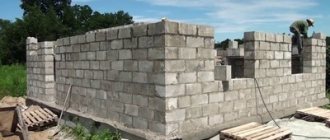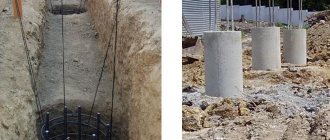How concrete gains strength
Concrete is an artificial stone. It consists of crushed stone, sand, cement, water and special additives. Crushed stone and sand provide strength, while cement and water form the “glue” that forms the monolith. Special additives make it possible to give concrete the necessary characteristics: rapid strength gain, the ability to lay in winter, frost resistance, and so on.
Concrete gains strength gradually; this process consists of two stages.
Grasping
– this is a loss of mobility of the solution. Its speed depends on the air temperature. For example, if it is +5 °C outside, the concrete will set in 15–20 hours, but the reference, or design, temperature is considered to be +20 °C. With it, setting occurs 1–3 hours after mixing the concrete mixture, that is, mixing all components with water. Before setting begins, you need to have time to place the mixture in the formwork, compact and level it.
Strengthening, or hardening
is the process of achieving a given strength by a concrete mixture. The optimal conditions for its collection are a temperature of +20 °C and a humidity level of 80%. The estimated period of “hardening” to brand strength at normal temperature and without additional measures is 28 days. Then the strength gain of concrete slows down, but does not stop growing throughout its entire service life.
Brand strength is an important characteristic of concrete. It is designated by the letter “M” and numbers from 50 to 1000 - the higher the index, the stronger the concrete. Physical and mechanical characteristics are determined by the selection of the composition of the concrete mixture, its water-cement ratio, as well as the quality of the components used: fillers, cement, water and additives.
Concreting technology in winter conditions
As part of the work project, activities are developed that ensure:
- Preventing concrete mortar from freezing during transportation, laying and compaction.
- Prevention of freezing of freshly laid concrete until critical strength is achieved.
- Favorable heat and humidity conditions for strengthening of hardening concrete.
Preparation of concrete in winter. Measures to prevent freezing of ready-mixed concrete during transportation, placement and compaction
The finished concrete mixture supplied to the construction site must have a temperature of at least 5°C. To do this, mixing is carried out in warm (up to 70°C) water, and the filling materials are heated.
Important!
The cement is not heated to avoid welding. The transportation time of the finished concrete solution should not exceed 4 hours.
Surfaces for concreting and reinforcement must be heated close to the temperature of the concrete solution, for which warm or hot air is used, but not steam or water.
When transporting the finished concrete mixture for a long time and it is impossible to use heating, antifreeze additives are used.
Measures to prevent freezing of concrete before reaching critical strength
There are two main methods of winter concreting:
- warm concrete;
- cold concrete.
Cold concrete is concrete that will harden without heating. To ensure its hardening, special antifreeze additives are designed to reduce the freezing point of water and at the same time accelerate hydration reactions so that the amount of unbound water in the solution decreases as quickly as possible.
Widespread antifreeze additives are electrolytes, Na and K salts, but their use has some limitations:
- sodium salts are not used in reinforced concrete, as they lead to corrosion of the reinforcement;
- some types of Portland cement (for example, highly alkaline or made from clinker with a high content of aluminosilicates) are not used in conjunction with electrolytes;
- sodium and potassium salts are not used in mixtures with potentially reactive rock filler;
- electrolyte salts should be tested experimentally for the formation of efflorescence.
Modern complex antifreeze additives do not have the disadvantages of electrolyte salts, provide the ability to carry out concrete work at low temperatures and have a complex effect (not only antifreeze, but also plasticizing and others).
Warm concrete is concrete that, after laying, is subjected to various heating and heating procedures.
Methods for heating concrete
After the concrete is laid and compacted, it is necessary to maintain an optimal temperature until critical strength is achieved, for which three types of measures are used:
- thermos method;
- construction of greenhouses;
- heating the concrete.
These measures are used both independently and in combination with antifreeze additives.
The choice of method depends on many factors:
- type of construction;
- composition of the concrete mixture;
- presence and type of fittings;
- presence or absence of appropriate equipment;
- economic expediency.
Heat conservation or "thermos method"
The thermos method is used in massive structures alone or in combination with accelerator additives. Accelerators contribute to faster hardening of concrete, which means that critical strength will be gained faster.
The hydration reaction is exothermic, that is, it occurs with the release of heat.
In massive structures, enough heat is released for heating, therefore, if you pour concrete into insulated formwork, and after pouring, cover it with PVC film and heat-insulating materials (mats, rolled materials, boards, foam), the concrete will maintain a temperature suitable for hardening up to a critical temperature strength.
Advantages of the method:
- energy saving;
- using concrete's own heat;
- relative simplicity.
Disadvantages of the thermos method:
- use only in massive structures;
- ineffectiveness at particularly low temperatures (solved by adding antifreeze additives);
- not suitable for designs with a large cooling surface area.
Hot dry thermos method
In this case, it is possible to lay concrete on a frozen base without heating. A layer of expanded clay heated to a temperature of 200–300°C is poured into the insulated formwork, and after it cools to 100°C, concrete mixed with warm water is laid. As a result, the heat from the cooling expanded clay is used to heat the concrete.
Construction of greenhouses
Teplyaks are a kind of tents that are installed above monolithic structures. Heat guns are installed inside the greenhouses in such a quantity as to ensure the required hardening temperature (above 5°C). The tightness of the shelter is of particular importance.
Methods for artificial heating of concrete
The highest rate of concrete hardening is at a temperature of 50°C.
It is possible to ensure the design temperature of concrete hardening until critical strength is achieved by using artificial heating of concrete using various methods:
- Electrode. Electrodes are fixed inside the formwork, which can be plate, strip, rod, or string. Heat is generated when current is passed through the concrete mixture.
- Conductive (contact). Heat is generated in the conductor when current passes through it and is transferred to the concrete mixture.
- Infrared. IR radiation is used to warm up the base, reinforcement and heat concrete without a heat carrier.
- Induction. Heat is generated by the fittings located in the electromagnetic field of the inductor.
The disadvantage of the methods is the need to use expensive equipment and electricity.
The use of anti-frost and accelerating additives allows concrete to quickly gain critical strength and thus save energy and increase equipment turnover.
Why increase the water resistance of concrete?
The higher the water resistance of concrete, the less susceptible it is to water pressure, as well as the effects of chemically aggressive substances in the soil and groundwater: acids, alkalis, salts, and so on. The water permeability of concrete is negatively affected by excess mixing water, undercompaction of the concrete mixture and lack of maintenance of freshly laid concrete.
Water that has not entered into the hydration of cement (the so-called transformation of a plastic mass into a monolith) forms pores in the concrete after evaporation. Some of them are not closed and form end-to-end channels. Moisture penetrates through them into the foundation, which expands when freezing, which contributes to the further destruction of concrete.
To reduce the amount of mixing water while maintaining the mobility of the concrete mixture, plasticizers are used. They reduce the water-cement ratio, reduce the pore volume in concrete and increase its density. It should be taken into account that it is necessary to select the composition of a specific concrete mixture in laboratories, taking into account the features and characteristics of the materials used: cement, coarse and fine aggregates and various additives.
During installation, special attention is paid to compacting the concrete. The concrete mixture must completely fill the required space without creating voids. This is especially important with dense reinforcement of the structure. For these purposes, special devices are used - deep and surface vibrators.
The use of additives to increase frost resistance
Frost-resistant additives, which prevent water crystallization, make it possible to carry out winter concreting without the use of energy-intensive heating processes.
Today in the construction industry various types of additives are used to improve the quality of concrete and its hardening.
To ensure the desired effect it is necessary:
- study the manufacturer's instructions;
- analyze the compatibility of components with the materials used.
Independent use of additives does not cause difficulties for private developers.
How to care for concrete after pouring
In concrete with a low water-cement ratio, it is necessary to retain water, which is needed for the hydration process. If this is neglected, the quality of the final product will noticeably decrease. The standard concrete care regimen involves moistening the freshly laid foundation every 3-4 hours for the first 3-5 days after pouring, depending on the ambient temperature. Also, the concreting area is covered with damp burlap or film, and special film-forming compounds are used.
Features of pouring the foundation depending on the type
The pile foundation is poured in winter using technology that involves heating and insulating the concrete.
The pile type of foundation is well suited for land plots with soft, loose soil. Such a foundation consists of piles that are immersed in the ground and connected to each other by reinforced concrete beams or a slab. With this arrangement of the foundation, it is necessary to transfer its loads to harder soil rocks. The depth to which the piles are laid depends on the geological features of the site. The best option for installing piles would be soil that freezes to a great depth.
The advantage of metal screw piles is that this type of foundation can be laid in the cold season. The advantage of winter installation is the integrity of the grass cover on the construction site, which will delight the owners with its appearance in the spring. The piles are made of steel, which withstands cold well.
To properly install a pile-screw foundation in winter, you need to perform the following steps:
- make markings and start screwing the piles, having previously made small pits (if you make them to the depth of soil freezing, then screwing will be no different from summer);
- if the ground is very frozen and cannot be drilled, you will have to preheat it with a fire;
- add anti-frost additives to the concrete (the cost of these materials is significant, but you need little concrete for such a foundation, so a small amount of additive will be required).
Let's look at how easy it is to lay a screw foundation in winter:
- Open up the top frozen layer of soil.
- Screw the piles into soft soil.
Unlike a strip foundation, a screw foundation has the following number of advantages:
- time savings associated with the quick installation of screw piles (1-2 days of work);
- cost savings compared to strip laying in winter;
- the ability to use screw piles with large differences in height and in the presence of “difficult soils”.
It is also possible to build a strip foundation in winter using frost-resistant additives, but experts recommend constructing it in winter from ready-made concrete blocks, where the mortar is poured only into the connecting seams.
There is a solution for winter laying, depending on what type of foundation you want to build for your house.
What are penetrating additives
To increase the water resistance grade of concrete, mineral materials of penetrating or penetrating action are often used. They are added to the mixture during preparation or applied to a prepared surface, that is, cleaned of dirt and cement laitance, as well as a water-saturated surface using a plaster sprayer or brush.
Active chemical additives in the material react with the components of the concrete mixture. As a result, insoluble compounds or crystals are formed. They create a continuous barrier that prevents the flow of water. Depending on the type of concrete being processed, the degree of its waterproofness can be increased by two or three levels.
What to look for when concreting a foundation
In order to competently carry out construction work and reduce further costs of repair and operation of the foundation to a minimum, you must adhere to a few simple rules:
- The foundation design should not allow cracks to form under any load.
- The entire volume of concrete must be poured without technological and “cold” joints, that is, in one technological cycle.
- If the work involves the formation of technological seams, they must be sealed using swelling cords, sealants or waterstops.
- Working reinforcement must be installed in strict accordance with the design; the thickness of the protective layer of concrete must be at least 15 mm.
- It is necessary to compact the laid concrete with vibrators or use self-compacting concrete.
- Newly laid concrete needs to be maintained.
The nuances of using antifreeze additives
It was already mentioned above that SP 70.13330 regulates the use of antifreeze additives. The fact is that antifreezes contain salts, and some additives, due to the presence of chlorides, can cause serious corrosion of steel reinforcement.
Each manufacturer has its own selection of additive components, but the main thing that a developer should remember when purchasing antifreeze additives is that he must choose a quality product from a well-established manufacturer. It should be written on the product packaging that the use of anti-frost additives in reinforced concrete structures is allowed.
Kirill Lebedev
If anti-frost additives are not used correctly in masonry mortars, in the spring, white stains (efflorescence) may appear on the facing brickwork. Therefore, you should strictly adhere to the manufacturer’s recommendations and use the dosage of antifreeze in strict accordance with the instructions.
Conclusions: The use of anti-frost additives ensures the continuity of the construction process at any external temperature and guarantees the quality and long service life of a country house. Although negative temperatures lead to increased costs associated with shorter working hours, additional costs for lighting, the need to heat workers and structures, etc., in winter prices for building materials, construction services, and equipment rentals decrease slightly. The cost of additives in the overall estimate for building a house is small. Therefore, with a competent approach, it is possible to bring the price of construction in winter and the price of construction in summer to a common denominator.
What time of year is best to pour the foundation?
Difficult weather conditions negatively affect the strength gain of concrete.
Abundance of precipitation
at the stage of setting the concrete mixture can lead to its saturation with excess moisture. This leads to an increase in the water-cement ratio and a decrease in the strength of concrete.
Frost
turn mixing water into ice, which disrupts the hydration process of cement. When water freezes, it expands and internal stresses arise in the freshly laid concrete, which leads to damage to the foundation.
High air temperature, low humidity and wind
increase the rate of water evaporation from freshly laid concrete. This leads to disruption of the process of cement hydration and destruction of concrete in the surface layer, the appearance of shrinkage cracks.
Based on this, and also taking into account that the process of concrete gaining strength lasts 28 days, the optimal time for pouring the foundation is the period from late spring to early summer.
In addition to the advantage of comfortable conditions for carrying out work, there will be enough time ahead to eliminate possible defects, arrange waterproofing and additional protection. As a result, a foundation built in the spring will not be afraid of autumn temperature changes and winter frosts.
What to add to concrete at sub-zero temperatures
Special anti-frost additives allow outdoor work to be carried out at low temperatures. These are chemical additives that are divided into several groups:
- Additives that prevent water from freezing are usually used with heating, which reduces the period of setting and hardening.
- Antifreeze-based additives; their task is to enhance the activity of cement at negative ambient temperatures. These additives are used without heating the structure; the concrete will gain the required strength without freezing the mass.
- Additives are accelerators of hardening of the cement mass with the release of heat, therefore, the monolithic mass is heated without the use of additional means - independently.
From a material point of view, the use of frost-resistant additives is the cheapest option, which is acceptable for any structure. The main rule is to fill the trench evenly, with tamping and compaction.
The peculiarity of these additives is the precise dosage during use, taking into account the massiveness of the product in each specific case. Some additives increase corrosion of the reinforcement belt, while others, on the contrary, increase the anti-corrosion properties of concrete. Therefore, they are often used together.
How to pour a foundation in winter
If it is still necessary to concrete the foundation in winter, several technological methods are used.
Antifreeze additives and hardening accelerators
– they allow work to be carried out at sub-zero temperatures without loss of speed and quality.
Heating concrete with an electric cable
– it is attached to the reinforcement frame and connected to the network, and then remains in the body of the concrete.
Warming up concrete with heat mats
– unlike cables, mats are installed on the surface of a heated structure and can be used repeatedly.
Arrangement of the greenhouse
− this is a structure similar to a greenhouse, which is assembled above the work site. Heat guns are installed inside to maintain positive temperatures, so in the “warmhouse” you can safely carry out foundation construction work: knitting the reinforcement frame, concreting, installing waterproofing and installing waterstops.
What is the difference between concreting in winter and summer?
The pouring process and methods of maintaining the properties of the solution in winter are more complicated. In the warm season, it is often enough to mix the components taking into account the proportions, prepare the formwork and reinforcing frame, and pour the mixture. Under normal conditions, strength gains occur in a shorter period of time:
- setting: this period lasts up to 24 hours, a thin layer of hydrosilicate is formed on the surface, at the same time the outer layers become denser;
- hardening: over the next 4 weeks, the mixture gains strength, after which further laying of building materials for the construction of walls becomes possible.
When it's frosty outside, the setting and hardening time increases. In addition, concreting in winter requires the use of special grades of cement:
- M200;
- M250;
- M300;
- M350;
- M400.
They are used under different conditions, but if the question of how to concrete in winter is being decided, then the indicated grades are the minimum acceptable for the construction of houses of a certain type.
For example, the foundation of a brick house in winter can be concreted with a mixture based on the M350 or M400 cement brand. More is possible, but not less.
In addition, in winter, before pouring the solution, auxiliary components are always added - special modifiers that improve the properties of the material. In case of mild cold weather, the covering method and insulation of the massif are sufficient. The stronger the frost, the more heating agents are used.
Monolithic slab before pouring
Bottom line
The optimal time for pouring the foundation in most regions of Russia, except the northern ones, is the second half of spring or early summer. During this period, the optimal weather for concreting work is established. Here are the main points to pay attention to when conducting them:
- Entrust the work of decoupling the reinforcement frame and concreting to a specialized organization. This way you will avoid mistakes, the correction of which can be very expensive.
- Use only ready-mixed concrete of appropriate strength and water resistance grades. Methods of preparing concrete on site in a metal bath and using shovels are strictly unacceptable.
- Carry out concrete work without forming cold joints.
- Increase the water resistance of concrete using special additives. For example, penetrating.
- Freshly laid concrete needs to be maintained. Cover it with damp burlap and water it every two or three hours, even at night, for 3 to 5 days. If the weather is hot, it is better to water within 7 days.
- Carry out foundation work in winter using special methods.
- If possible, check the thickness of the concrete cover using a rebar locator. It must be at least 15 mm.
- Additionally, protect foundation structures from the negative effects of soil and groundwater.
Advantages and disadvantages
We propose to understand the pros and cons of building a foundation in winter.
Benefits include:
- convenience of preparing a pit or trench in an area where the soil composition does not hold its shape well in the warm season;
- during the winter season, building a foundation in the North is a completely justified decision;
- acceptable cost of materials for which demand temporarily falls;
- availability of free time.
Unfortunately, there are also certain disadvantages. If in the summer it is possible to prepare a trench with your own hands, then in the winter season it becomes necessary to use special equipment to cope with frozen soil. The risk of purchasing low-quality building materials that suppliers were unable to get rid of during the season increases. Added concerns about how to preserve the foundation for the winter.

